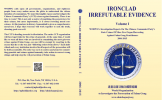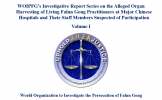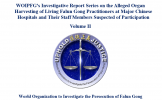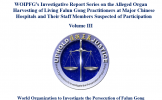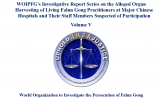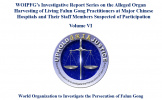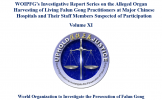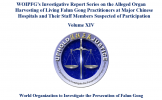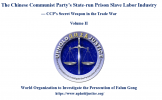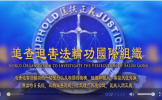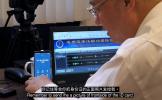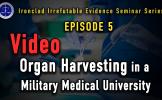An Investigative Report on the Source of Human Cadavers Used in the Plastination Industry in China
Foreword
I. Main providers of “fresh cadavers” for plastination are public security, procuratorate and court systems
II. Many “fresh cadavers” are likely to have been persecuted Falun Gong practitioners
III. Sale and exhibition of plastinated bodies brought huge profit, Chinese regime claiming to have generated the “world’s largest plastination business”
IV. Human cadaver plastination industry thrives due to support of the Chinese regime
Conclusion
Foreword
In today’s China, human body plastination has become a hugely profitable business. China is the only country where such a business has been made possible by the government. The human body plastination business started around year 2000 when the Chinese regime intensified its persecution of Falun Gong practitioners. Subsequently, the plastination industry in China thrived during the peak of the persecution.
Human body plastination is a process to preserve human body or body parts by replacing water and lipid tissues with curable polymers, such as silicone, epoxy and polyester-copolymer [1]. The only bottleneck of this process is the availability of “human cadavers.” Moreover, the plastination process requires fresh cadavers, which have not been treated with preservatives such as formalin[2]. According to the rules of medical examination, a human corpse that is within 2 days of mortality is considered fresh [3].
Dalian Hoffen Bio-Technique Co., Ltd. (referred to as “Dalian Hoffen” in this report), located in Dalian City of China’s northeastern province of Liaoning, was founded in 2004 when Bo Xilai was Governor of Liaoning Province and the Deputy Chief of the Provincial Party Committee. Dalian Hoffen is a “human body plastination” factory utilizing solely Chinese bodies.
The General Manager of Dalian Hoffen and Director of Department of Anatomy at Dalian Medical University, Sui Hongjin [4] once claimed that some “cadavers” were from the Public Security Bureau, and that the reason Dalian Hoffen could become “the largest human body plastination factory in the world” was due to the “caring and support” from “government officials of various levels.” In fact, many Chinese Communist Party (CCP) officials and government agencies have been involved in one way or another in the plastination business.
World Organization to Investigate the Persecution of Falun Gong (WOIPFG) has published reports on Falun Gong practitioners killed for their organs [5]. This report focuses on the source of the cadavers used for plastination. The Chinese regime’s public security, procuratorate and court systems, controlled by the Political & Legal Affairs Committee (PLAC), are not only the main agencies to persecute Falun Gong, but also the providers of “fresh human corpses.”
I. Main providers of “fresh cadavers” for plastination are public security, procuratorate and court systems
1. Human body plastination process requires “fresh cadavers” with no preservatives
According to the “Regulations on Dissection of Corpses” issued by the Ministry of Health on Feb. 22, 1979, if a human corpse remains unclaimed for at least one month, it is deemed “unclaimed” and can be used for anatomy studies by medical schools. In order to use the corpses, medical schools must obtain permits from relevant government agencies or the Public Security Bureau[6]. The “Regulation” has been implemented by the Ministry of Public Security.
In order to keep the “unclaimed” bodies suitable for anatomy studies after one month’s wait time, the bodies must be treated with preservatives. Otherwise, within 10 to 23 days after death, the corpse will have only hair, skin, bone and cartilage left [7].
However, many plastination related reports generated by Chinese research institutes claim that they only use “fresh” bodies. Some go into details aobut the corpses, such as “fresh adult corpse with no external wounds and pathological changes,” and must be “between 25 and 40 years old.”
The following are some examples of such “fresh corpses” in use for plastination purpose.
Gunter von Hagens, the inventor of the plastination process, was Sui Hongjin’s teacher in Germany and later Sui’s boss in the Von Hagens Plastination factory in Dalian. On Dec. 29, 2001, Hagens received an encrypted email from Sui. It reads, “This morning, two fresh, top quality corpses arrived at the factory. The livers were removed only a few hours ago [8].”
A 2005 research report by Shandong Province Weifang Medical College Department of Anatomy said, “take fresh adult corpses with no external wounds and pathological changes, inject 8,000ml formalin through the cerebral arteries, then inject silicone … [9]” What could be the cause of death of those corpses “with no external wounds and pathological changes”?
A 2006 research report by the People’s Liberation Army Lanzhou Region General Hospital said, “choose 8 male corpses of ages between 25 and 40 with good teeth structure; take the heads and dissect them into 8cm x 8cm x 10cm specimens …” The report was a program of National Natural Science Foundation of China [10].
A 2006 Shandong University Ph.D. thesis on liver segmental anatomy said that the “experimental materials were 15 fresh human cadaver livers [11].”
An announcement issued by Hunan Province Changde municipal government on Nov. 10, 2011 said, “Changde Technical Vocational School only uses single source for human specimen because human body plastination requires fresh, unpreserved human bodies [12].”
2. Most corpses were from public security, procuratorate and court systems
When asked about the source of the bodies used in his plastination factory in Dalian, Sui Hongjin [13] answered, “The bodies were used by medical schools for anatomy study. The medical schools obtained the bodies as ‘unclaimed corpses.’ [14]” However, those bodies were plastinated in Sui Hongjin’s factory within hours, not exceeding 2 days, of death. The bodies were indeed unclaimed or it might be that the bodies were not even allowed to be claimed. Where did Sui Hongjin get so many “fresh bodies” to support the lucrative plastination business?
In 2004, the German news magazine “Der Spiegal” obtained evidence [15] confirming that in the “fetus and infant database” maintained by the Von Hagens Plastination factory in Dalian, there was a detailed record of a 9-month-old fetus labeled 01BR01. The male fetus arrived at the factory on March 26, 2001. His nationality was “mainland China” (Inlaendich). His origin was clearly written as “Public Security Bureau.” How could a 9-month-old fetus end up in the Public Security Bureau?
In May 2008, a settlement with the attorney general of New York obliged Premier Exhibitions, Sui Hongjin’s exhibition partner, to publish a disclaimer on its website and at the exhibition hall [16]. The disclaimer clearly states that the origin of Dalian Hoffen’s cadavers was from “the Chinese Bureau of Police.”
The disclaimer reads:
This exhibit displays human remains of Chinese citizens or residents which were originally received by the Chinese Bureau of Police. The Chinese Bureau of Police may receive bodies from Chinese prisons. Premier cannot independently verify that the human remains you are viewing are not those of persons who were incarcerated in Chinese prisons.
This exhibit displays full body cadavers as well as human body parts, organs, fetuses and embryos that come from cadavers of Chinese citizens or residents. With respect to the human parts, organs, fetuses and embryos you are viewing, Premier relies solely on the representations of its Chinese partners and cannot independently verify that they do not belong to persons executed while incarcerated in Chinese prisons.

Image1: Premier Exhibitions, Inc. Publishes Disclaimer on its Website
3. Telephone Recording between a WOIPFG investigator and Sui Hongjin
In 2012, WOIPFG conducted telephone investigation with Sui Hongjin. Sui admitted that some “cadavers” were from Dalian Public Security Bureau.
Listen to original recording in Chinese:
Download: MP3
Transcript:
Operator: “Hello, thank you for calling Dalian Hoffen, please dial the extension, or press 0 for directory.”
Sui Hongjin: Hello,
Investigator: Hello, we would like to speak to professor Sui Hongjin.
Sui: Who are you?
Investigator: I am so-and-so (omitted). Are you professor Sui?
Sui: Yes.
Investigator: When Bo Xilai was in charge of Dalian, Von Hagens Plastination Factory was established. You worked there as the general manager, right?
Sui: Right.
Investigator: Please tell us about the relationship between Bo Xilai, his wife Gu Kailai and the Hagens Factory. What kind of relationship do they have?
Sui: Because I handled this matter, mainly was thinking that, Hagens was given an award …, Dalian Xinghai Friendship Award.
Investigator: yes.
Sui: Hagens happened to be there when the award was being issued… the Friendship Award.
Investigator: oh.
Sui: He got the award, and then he was given the award on a ceremony.
Investigator: oh.
Sui: Later, Hagens himself took advantage of this honor,
Investigator: oh.
Sui: Hagens bragged about his intimate relationship with Bo Xilai. Then I left his company.
Investigator: We know about this.
Sui: Hagens used his relationship with Bo Xilai, the mayor.
Investigator: oh
Sui: Hagens met Bo Xilai during the award ceremony,
Investigator: oh
Sui: and they took a picture together.
Investigator: What is the main source of the corpses your company used?
Sui: A few dozens were from the Public Security Bureau. That’s it, from the Public Security.
Investigator: From the Public Security. How many in total have you gotten from the Public Security Bureau?
Sui: I can’t remember now, a few dozen.
Investigator: ah
Sui: If you come in person to investigate, I can tell you about this. It is not very appropriate to talk about this on the phone.
Investigator: Which Public Security Bureau provided you (the corpses)?
Sui: oh … Dalian city, Dalian Public Security Bureau.
Investigator: So the corpses you used were from the Public Security Bureau. Do you know where they got those corpses?
Sui: They … should be … how do I say it, it was around 2004, they had an internal report, about …
Investigator: oh
Sui: the report was for the Ministry of Public Security.
Investigator: oh
Sui: Because I only cared about the results of some specific things, it was not good for me to ask for too many details. Why don’t you … hmm … just because this matter is very sensitive, I am willing to cooperate with you,
Investigator: ah, ah,
Sui: If necessary, I can talk to you face to face. I can also provide my signature. I will be responsible for my words.
Investigator: Which department is directly controlling your company? Is it Dalian Medical University?
Sui: Yes. About the Hagens situation, I am more familiar with it than the university.
Investigator: Good. Thank you for your cooperation.
Sui: You are welcome.
Investigator: Good. That’s it for now. Goodbye.
Sui: Goodbye.
The Health Care Ethnic Training magazine is affiliated with the Department of Education at the Ministry of Health and Department of Health of Gansu Province [17]. In 2004, a thesis titled “The Collection of Human Cadavers” was published in the magazine. The article says “obtaining the support from the public security, procuratorate and court system is essential, since they are the main sources of the cadavers [18].”
At that time, the head of Liaoning provincial Political & Legal Affairs Committee and Public Security Bureau was Li Feng [19] (2001 - 2011 [20]). Dalian municipal Public Security Bureau was headed by Sun Guangtian [21] (April 25, 2000 - March 2003) and Zhang Jixian [22] (September 2004 - December 2009 [23]).
II. Many “Fresh Cadavers” are Likely to Have Been Persecuted Falun Gong Practitioners
WOIPFG investigations have confirmed that the “fresh cadavers” were neither from “donations” nor from "unclaimed corpses.” Many were from Falun Gong practitioners, who were killed by the Chinese regime.
1. Premier Exhibitions “cannot independently verify the origin of bodies”
Sui Hongjin’s partner, U.S. based Premier Exhibitions affirms in its disclaimer [24] as such: “This exhibit displays full body cadavers as well as human body parts, organs, fetuses and embryos that come from cadavers of Chinese citizens or residents. With respect to the human parts, organs, fetuses and embryos you are viewing, Premier relies solely on the representations of its Chinese partners and cannot independently verify that they do not belong to persons executed while incarcerated in Chinese prisons.”
2. Sui Hongjin did not receive any donated or corpses from executed prisoners
In an interview with the Southern Metropolis Daily on Aug. 17, 2012, Sui Hongjin said, "In fact, none of the cadavers were from executed prisoners. Since the first day of Dalian Hoffen, we have never used any such corpses!” On Aug. 22, 2012, in another interview with the Southern Metropolis Daily, Sui Hongjin said, “So far none of the bodies we used for plastination is from donation [25].”
According to Chinese law, if a human corpse remains unclaimed for at least 30 days, it is deemed “unclaimed corpse” and can be used for anatomy studies by medical schools. However, Sui Hongjin’s company has been using fresh human cadavers, i.e., a few hours to two days after death, to make plastinated specimens for exhibition and commercial trade. Those “unclaimed” bodies did not even go through the procedure of identification. Sui’s company has no apparent consent from the deceased or their family members.
3. Gunter von Hagens: “It is impossible to receive donated bodies in China”
On Oct. 21, 2003, Hagens wrote in an email: "So far, we haven’t received any donated bodies yet in China [26]." On Aug. 17, 2012, Gunter Von Hagens’ son told Deutsche Welle that until then they had received one Chinese cadaver [27].
In July 1999, soon after the Jiang Zemin led Chinese regime started to persecute Falun Gong, large number of Falun Gong practitioners were arrested. Prisons and labor camps around China were quickly over-crowded with Falun Gong practitioners. In 2001, the State Council issued “Meeting Minutes on Solving Prison Issues” (State Council [2001] number 73) [28]. In 2002, the CCP started modifying over 700 prisons. (Note: Data on CCP’s construction and expansion of labor camps is not publicly available.) Then Minister of Justice, Zhang Fusen said prisons located in remote areas should be moved to areas closer to city centers and transportation hubs [29].
Liaoning Province acted quickly and in a very large scale. Bo Xilai was the Governor of Liaoning at the time. He personally chaired meetings to discuss plans to upgrade prisons in the province. The plans were then reported to the State Council. The Ministry of Justice clearly indicated that the plans from Liaoning Province should be included in the list of projects of national importance [30]. Eleven months later, in July 2003, the Shenyang City Prison Compound opened. The 400,000 square meter Compound consists of several prisons. The 1 billion yuan project was sponsored by CCP Central and the local government, and claims to be able to hold over 10,000 prisoners [31].
Sui Hongjin [32] and his German boss Gunther von Hagens’ body factory was located in Gan Jingzi District of Dalian City [33], which is about 150 kilometers from the Shenyang City Prison Compound.
The Falun Gong practitioners from the northeastern provinces and Beijing were transferred to the newly built Shenyang City Prison Compound [34], where Liaoning No. 1 Prison, Liaoning No. 2 Prison, Xinren Prison and Liaoning Female Prison are located [35]. It is estimated over 2,000 Falun Gong practitioners were held at the Compound.
On Feb. 23, 2004, as part of the plan to upgrade prisons in Liaoning Province, Nan Guangling Prison in Dalian City was given 180 million yuan for expansion [36], and would be combined with Dalian Prison [37]. Nan Guangling Prison was located in the same district as the Hagens Plastination Factory. Three months later, after spending 227 million yuan, Dalian Labor Camp was expanded to 236,700 square meters [38]. Both Nan Guanling Prison and Dalian Labor Camp are notorious for the severe persecution of Falun Gong practitioners [39]. On March 19, 2001, just prior to the International Human Rights Conference, over 400 Falun Gong practitioners illegally detained in Dalian Labor Camp were subject to brutal tortures for three days and three nights [40]. By 2004, according to incomplete statistics, at least 14 Falun Gong practitioners were confirmed, with their real names, tortured to death [41].

Image 2: At the Hagens Dalian Plastination Factory, Chinese workers busy working on the human corpses

Image 3: Gunter von Hagens teaching Chinese workers plastination techniques at his Dalian Plastination Factory
III. Sale and exhibition of plastinated bodies brought huge profit, Chinese regime claiming to have generated the “world’s largest plastination business” [42]
On May 12, 2006, the Chinese regime’s nine ministries and administrations jointly adopted the “Provisions on the Administration of Entry and Exit of Cadavers and Treatment of Cadavers.” Article 2 says: “The term cadavers as mentioned in the present Provisions shall refer to the dead human bodies and the specimens thereof (including human organs and tissues, human bones and the specimens thereof).” Article 8 says: “Trading of cadavers is strictly prohibited. Commercial activities using cadavers are strictly prohibited [43].”
However, the so-called law enforcement agencies under CCP control are usually tools for the CCP officials to pursuit individual interests. Since former CCP head Jiang Zemin started the persecution of Falun Gong in 1999, the entire state apparatus, including the law enforcement organs, existed largely for persecution. Law and regulations were destroyed and human cadaver sale and plastination business became rampant. Even the government agencies were actively participating as buyers of plastinated human specimens. The provider, Dalian Medical University Plastination Co., Ltd. was particularly active.
1. Plastinated Human Body Specimen Bidding Announcements
Guangzhou Medical University full-body plastinated specimen (Bidding number: PSP-GZ-0106115) [44]
Bidding Start Date: Dec. 1, 2006
Bidding End Date: Dec. 13, 2006
Specimen Description: full-body nerve system, full-body artery and vein (shallow layer on one side, deep layer on the other side) plastinated model
Provider: Dalian Medical University Plastination Co., Ltd.
Price: 135,000 yuan
Specimen Description: Full-body artery plastinated model (shallow layer on one side, deep layer on the other side)
Provider: Dalian Medical University Plastination Co., Ltd.
Agreed Price: 120,000 yuan
Sourcing Contact: Guangzhou Medical University, a faculty surnamed Luo
Sourcing Agency: Guangzhou Bidding Representative Co., Ltd. Ms. Chan
Specimen Description: full-body joints and organ plastinated model
Provider: Qingdao Keyi Biotechnology Co., Ltd.
Price: 75,000 yuan
Specimen description: full-body muscle plastinated model (shallow and deep layer)
Provider: Qingdao Keyi Biotechnology Co., Ltd.
Price: 75,000 yuan
Sourcing Contact: Guangzhou Medical University, a faculty surnamed Luo
Sourcing Agency: Guangzhou Bidding Representative Co., Ltd. Ms. Chan
“Shanghai Jiaotong University Medical School Plastinated Human Bodies 0811-DSITC09202” Bidding Program [45]
The chinabidding.com website is approved by the Ministry of Commerce, the Ministry of Finance and National Development and Reform Commission [46]
Bidding Open: Sept. 24, 2009
Bidding Close: Oct. 10, 2009
Winning Tenderer: Dalian Hoffen Bio-Technology Co., Ltd.
Tender: Shanghai Dongsong International Trading Co., Ltd.
Mudanjiang Medical University Human Body Teaching Model and Service Bidding Announcement on Mudanjiang municipal government website [47]:
Bidding Start: June 30, 2011
Tenderer Announcement: Feb. 15, 2012
Winning Tenderer: Dalian Hoffen
Price: 997,000 yuan
An announcement by Changde Technical Vocational School, Hunan Province [48]
Date: Nov. 10, 2011
Budget: 940,000 yuan
Successful Bidder: Zhengzhou City Hongke Weijiao Trading Co. Ltd.
Reason for single bidder: “The use of single source for human specimen is because human body plastination requires fresh, unpreserved human bodies. The human body mushroom shaped specimen and human body meridian specimen are only provided by Zhengzhou City Hongke Weijiao Trading Co. Ltd.”
Contact: Luo Ling from Changde Technical Vocational School
2. Plastinated Human Body Specimens for Sale Online
Dalian Medical University Plastination Co., Ltd. online shop
Sui Hongjin’s Dalian Medical University Plastination Co., Ltd. advertises its human specimens online. On a website specializing in educational equipment, under the category of “plastinated human specimen” were 7 sub-categories, namely digestive system, nervous system, reproductive system, endocrine system, urogenital system, respiratory system and sensory system. Every “product,” such a “plastinated brain [49],” a “plastinated renovascular system [50],” a “plastinated heart and lung combine specimen [51],” “plastinated bronchial tube and pulmonary artery [52],” “plastinated bronchial tube and pulmonary vein [53],” “fetus 10 to 32 weeks [54]” all marked with “price negotiable face-to-face.”

Image 4: "Fetus 10 to 32 weeks" price negotiable, provided by Dalian Medical University Plastination Co. Ltd.
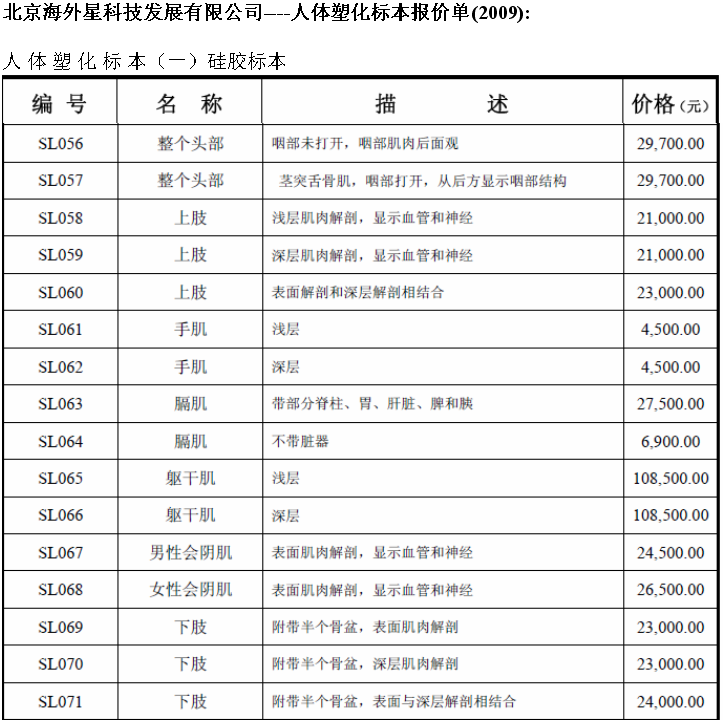
Image 5: Products by Beijing Haiwaixing Science & Technology Development Co., Ltd. (See translation below)
Plastinated Human Body Parts Price List, 2009
| Item Number | Item Name | Description | Price(yuan) |
| SL056 | Whole head | Throat is not opened, throat muscle visible from the back | 29,700 |
| SL057 | Whole head | Throat is opened, showing stylohyoid, throat structure visible from the back | 29,700 |
| SL058 | Arm | Surface muscle dissection showing blood vessels and nerves | 21,000 |
| SL059 | Arm | Deep muscle dissection showing blood vessels and nerves | 21,000 |
| SL060 | Arm | Combination of surface and deep muscle dissection | 23,000 |
| SL061 | Hand | Surface muscle dissection | 4,500 |
| SL062 | Hand | Deep muscle dissection | 4,500 |
| SL063 | Diaphragmatic muscle | Attached: partial spine, stomach, liver, spleen, pancreas | 27,500 |
| SL064 | Diaphragmatic muscle | No organs attached | 6,900 |
| SL065 | Spinal muscle | Surface | 108,500 |
| SL066 | Spinal muscle | deep | 108,500 |
| SL066 | Spinal muscle | deep | 108,500 |
| SL067 | Male perineal muscles | Surface muscle dissection showing blood vessels and nerve | 24,500 |
| SL068 | Female perineal muscles | Surface muscle dissection showing blood vessels and nerve | 26,500 |
| SL069 | Leg | Half pelvis attached, surface muscle anatomy | 23,000 |
| SL070 | Leg | Half pelvis attached, deep muscle dissection | 23,000 |
| SL071 | Leg | Half pelvis attached, surface and deep muscle dissection combined |
24,000 |
3. Human Body Exhibition Functions as Trade Show
On April 8, 2004, the “Body Worlds” exhibition, which was organized by the Chinese Society for Anatomy and approved by the Ministry of Health and China Association for Science and Technology, officially opened at the Exhibition Hall of China Architectural Culture Center in Beijing. The exhibition displayed 20 full body specimens and over 200 human organ specimens. The full body specimens showed various height and weight, male and female, and were “plastinated” into various postures [55].
The plasinated human vascular system requires the cadaver to be fresh, free of preservatives. The blood vessels must be without damage in order for the fluid to flow freely. The specimen is made by injecting plastination materials into vessels, organs and excreting channels. The body can then be molded into shape. Acids, alkalis or natrual corrosion chemicals are then added. After the organs are removed, the leftover vessels become the specimen [56].
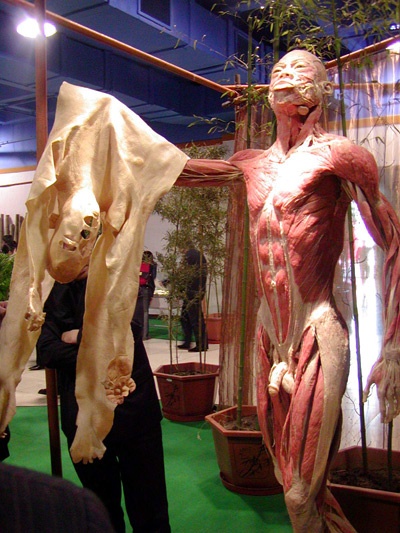
Image 6: Sui Hongjin's the “Skin Carrier” specimen shows a male cadaver holding the complete set of his own skin [57]
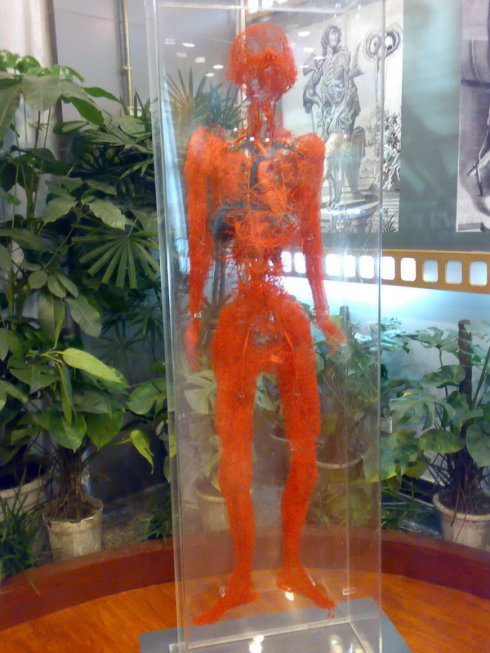
Image7: The "Big Red Man" is a plastinated full body showing the complete vascular system by Sui Hongjin and his colleagues [58]
The “Female with Fetus” specimen is a standing female anatomical specimen. The muscle shows pinkish tone. One can clearly see the lungs, heart, ovary and womb, where a three-month old fetus lies. Wang Jian, deputy general manager of Dalian Hoffen said: “The ‘Female with Fetus’ specimen is the only such type in China [59].
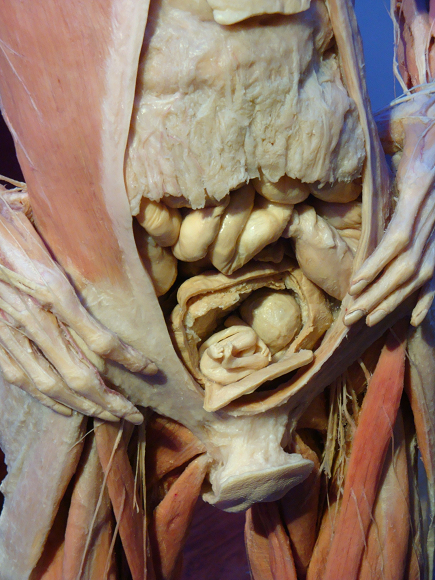
Image8: Female with Fetus Half Body Enlarged Picture
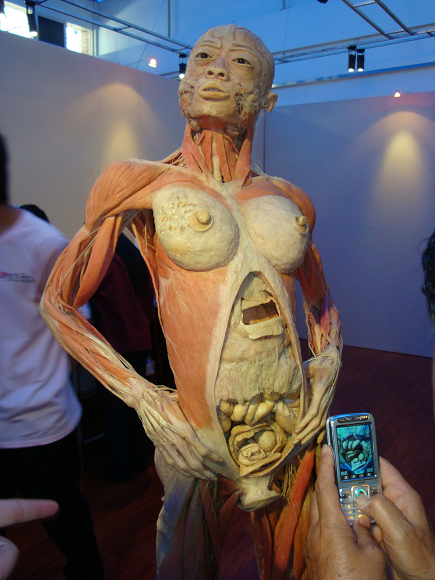
Image9: Full Body Female with Fetus
According to Chinese law, pregnant women cannot be given the death penalty. Even if the woman died in a car accident, her family would be extremely unlikely to allow their loved ones’ bodies to be made into human specimens.
These specimens were all provided by Sui Hongjin and his colleagues at Dalian Medical University Plastination Co., Ltd. These plastinated human bodies have one thing in common, which is that their skin has been completely removed so that “no one can identify them,” Sui Hongjin explained [60]. Under the banner of “science education,” the specimens at the exhibition were priced ranging from tens of thousands yuan to several million yuan, turning the exhibition into a trade show [61]. The admission fee was 50 yuan for adults and 25 yuan for students [62].
4. China has become the largest exporter of human specimens
(1) Gunter von Hagens sold plastinated Chinese corpses to the rest of the world
On Jan. 22, 2004, while in Frankfurt Von Hagens told Deutsche Welle, “In the making of human specimen, we never use corpses of executed prisoners [63].” However, Hagens never denied using corpses of Chinese people to make human specimen. In order to “refute” Der Spiegel’s accusation (in its Jan. 19, 2004 report) of him using the corpses of Chinese prisoners, Hagens “immediately ordered his Dalian plastination factory workers to check the 650 cadavers for gunshot wounds [64]. That is to say, if none of the 650 cadavers were Chinese, then there is no need to check for gunshot wounds. It turned out that “7 cadavers had head injuries [65]. This suggests that the 7 people may have been executed prisoners.On Oct. 21, 2003, Von Hagens said that he could not “get any donated bodies in China.” This suggests that the 7 cadavers with head wounds may have been executed prisoners. Then who were the rest 643 Chinese bodies?
Oriental Outlook Weekly reported on November 24, 2003, that Von Hagens Plastination Co., Ltd, a German-owned enterprise in Dalian has trafficked many Chinese corpse-made specimens to the rest of the world and earned hundreds of millions of dollars in profit [66]. Von Hagens Plastination Co., Ltd. was established in August 1999 with the approval of Dalian municipal government [67]. In 2003, Sui Hongjin, former general manager of Von Hagens Plastination Co. Ltd., told Oriental Outlook, “Hagens did not intend to hold exhibitions in China because there would not be as much profit. He only intended to make China his production base because the cost of labor and raw material are a lot lower in China [68].”
Before its production halt in 2006, Von Hagens Plastination (Dalian) Co., Ltd. reported an annual income of 131.69 million yuan, and 714.66 million yuan in total assets. The address of the company was 27 Qixianling Gaoneng Street, Hi-tech Zone, Ganjingzi District, Dalian City, Liaoning Province [69].
(2) Sui Hongjin sold plastinated Chinese corpses to the rest of the world
From 2004 to 2012, Sui Hongjin’s human body exhibitions appeared in over 60 cities and over 20 countries. Exactly how many Chinese bodies had been plastinated and sold to the U.S. and European countries by Sui Hongjin? Given the current situation in mainland China, it is still difficult to even come up with an estimate.
In the United States, Sui Hongjin’s human body exhibition is called “BODIES-The Exhibition”
In 2005, Sui Hongjin collaborated with U.S.-based Premier Exhibitions to open the “BODIES-The Exhibition” in America [70]. The specimens were provided by Dalian Hoffen. According to Sui, they signed a five year lease agreement and Premier Exhibitions paid $25 million dollars for the lease [71]. The first exhibition opened in New York (11 Fulton Street, lower Manhattan) on Nov. 19, 2005. The exhibition displayed 22 full body specimens and over 260 body parts made from Chinese corpses. The admission fee was $24.50 each [72]. By 2012, Premier Exhibitions has increased its collections to “over 200 actual human bodies and specimens meticulously dissected and respectfully displayed [73].”
Sui Hongjin’s BODIES--The Exhibition has become a major source of revenue for Premier Exhibitions. In Las Vegas, New York and Atlanta, where Premier Exhibitions headquarter is, BODIES has been on permanent display charging over $20 dollars per ticket [74]. The official website of BODIES - The Exhibition claims that “BODIES has been experienced by more than 15 million people worldwide [75].” A Southern Metropolis reporter checked the annual report of Premiere Exhibitions. The 2009 10-k form indicates 19 percent of the company's revenue came from Titanic and 67 percent of the revenue came from BODIES – The Exhibition.
In Europe, Sui Hongjin’s human body exhibition is called The Human Body (or THB)
The Human Body premiered in Dublin, Ireland on Feb. 2, 2012 “featuring more than 200 real human body specimens.” It lasted until July 31, 2012. Similar exhibitions had attractd over 20 million visitors worldwide [76]. Sui Hongjin’s partner for the European exhibitions is Florida-based HK Exhibitions. Sui Hongjing wrote in a statement to HK Exhibitions saying: “Dalian Hoffen only accepts specimens that have been legally donated, are free of infectious disease and certified to have died of natural causes [77]. “ However, in August 2012 Sui Hongjin told Southern Metropolis that “none of our plastinated human specimens were from donated corpses.”
During the six-month exhibition in Dublin, THB exhibitions were also held in other European countries.
From February 24 to May 27, 2012, THB exhibition was held in Budapest, Hungary. The description of the exhibition said, “All of the bodies were obtained through the Dalian Medical University Plastination Laboratories in the People’s Republic of China [78].” Another report mentioned that HK Exhibitions Inc. was the organizer of this exhibition and that “This exhibition attracted more than 300 thousand visitors in 2008 in Budapest. The Human Body was enriched with new attractions, and presents more than 150 human bodies and body-parts [79].”
From June 16 to September 9, 2012, The Human Body was in Ostend - Flanders, Belgium [80].
From March 10 to June 10, 2012, THB was held in Prague, Czech Republic. When asked about the source of the corpses, local organizers responded: “The entire exhibition was brought here and cleared as customs as an art collection, so nobody requested to see any documents proving the origin of the bodies, and I suppose nobody will want to see it anyway. The bodies were, however, provided by the Chinese government, so the main organizer, which is an American company, does have a document from the Chinese government [81].”
Sui Hongjin’s Dalian Hoffen Bio-Technique Co., Ltd. [82] also owns Dalian Medical University Plastination Co., Ltd., Dalian Hoffen Cultural Development Co., Ltd. [83] and Dalian Jinshitan Life and Mystery Museum [84]. The three subsidiaries use the same address: 36 Guangyuan Street, Lushun Economic Development Zone, Dalian. Sui Hongjin is the legal representative and general manager [85]. Wang Hongchun is the vice chairman and deputy general manager [86]. The company’s main operation is “plastination specimens” and “popular science exhibitions” [87]. Dalian Television Station reported on Nov. 23, 2010, “On Nov. 21, 2009, the State Council and the Central Military Commission had formally approved the opening-up of Lushun Economic Zone. By the end of 2009, Dalian Hoffen located in Lushun Economic Zone began its operation. Its annual income reached over 200 million yuan. It has business relations with over 100 well-known museums around the world. The opening-up of ports was the main factor that Dalian Hoffen chose to operate in Lushun [88].”
IV. Chinese Government’s Support Made Human Cadaver Plastination Business Thrive
According to an Aug. 23, 2012 article on Southern Metropolis Daily, there are several dozens of human body plastination factories in China. Among those, the Von Hagens factory and Sui Hongjin’s Dalian Hoffen are the largest and both are located in Dalian City. According to Sui Hongjin, the rest of the factories amount to only 10 percent of the business [89].
1. Hagens Plastination Technology “imported” to China by Sui Hongjin
In January 1994 when Bo Xilai was the mayor of Dalian City, Liaoning Province, Sui Hongjin, a teacher at Dalian Medical University, was sent to Germany to study plastination under Gunther von Hagens. Sui Hongjin played a key role in establishing the collaboration between Hagens and Dalian Medical University. In December 1996, Hagens founded Hagens Institute of Plastination in Dalian, the first such institute in China [90]. Sui Hongjin was appointed the director of Hagens Institute of Plastination [91].
In August 1999, one month after the CCP launched the persecution against Falun Gong, Dalian municipal government approved Hagens to invest 15 million dollars in a solely foreign-owned enterprise, Von Hagens Plastination Ltd., in Dalian Hi-tech Zone [92]. (Foreign Investment Approval Certificate: Foreign Trade and Economic Cooperation [1999] No. 0298. Business license registration number: solely foreign-owned enterprises [1999] No. 07598) [93]. Sui Hongjin was appointed General Manager [94]. In December 2000, as an exception to the usual promotion rule, Sui Hongjin was appointed to professor and director of Anatomy Department at Dalian Medical University [95].
2. Two consecutive mayors of Dalian City awarded Hagens
In September 1999, at the Xinghai Friendship Award ceremony, Bo Xilai, then mayor of Dalian City, delivered the award certificate and medal to Hagens. Sui Hongjin later said, “I know about this award. Hagens happened to be there when the award was being issued. Later, Hagens bragged about his intimate relationship with Bo Xilai [96].”
In July 2002, Dalian municipal government awarded Von Hagens Plastination Ltd. the title of “Hi-tech Enterprise” based on its allegedly advanced plastination technology [97]. At that time, Bo Xilai was promoted to the Governor of Liaoning Province [98], the mayor of Dalian was Xia Deren [99].
3. Sui Hongjin broke away from Hagens, plastination became “localized”
In 2000, the Ministry of Health and Chinese Association of Science and Technology approved Sun Hongjin’s application to hold China’s first plastinated human body exhibition, “The Body World Exhibit,” scheduled in 2004 [100]. According to Dalian Hoffen Bio-Technique Co., Ltd.’s explanation, “In order to develop China's own plastination technology [101],” on June 21, 2002, with the support of Dalian Medical University, Sui Hongjin established his own business [102]. Without notifying Hagens, Sui registered an university-owned enterprise, Dalian Medical University Plastination Co. Ltd. The registered investment was 1 million yuan [103]. When Hagens eventually found out about Sui Hongjin’s own plastination company, Hagens fired his general manager, Sui Hongjin [104].
4. Sui Hongjin received “caring support from officials of various levels”
In January 2004, Sui Hongjin expanded his operation and established Dalian Hoffen Bio-Technique Co., Ltd. and served as Chairman of the Board [105]. The company was locat106ed in Dalian Hi-tech Zone []. It enjoyed the Dalian municipal tax break [107].
According to “Window of the Northeast”, a magazine affiliated with Dalian municipal Party Committee [108], “Sui Hongjin was very encouraged by the enthusiastic support for the “Body World Exhibit” from officials of all levels. The Ministry of Health and Chinese Association of Science and Technology approved his application, thus ensured the normality and legitimacy of the exhibition. Wu Jieping, then Vice Chairman of the National People’s Conference, wrote the name of the exhibition in Chinese calligraphy. Xue Shepu, member of Chinese Academy of Sciences, and chairman of Chinese Anatomy Society wrote the introduction for the books accompanied the exhibition. During the exhibition, Wu Yi, the Vice Premier of the State Council, asked the officials from the Ministry of Health to attend the exhibition to provide guidance and conduct field research [109].”
During the preparation for the “Body World” exhibition, Sui Hongjin was sent to Austria, Australia, Spain and other countries to participate in international Symposiums on plastination.
5. The Central Propaganda Department and the Ministry of Health help remove “social controversy” surrounding Sui Hongjin’s exhibition
On Jan 1, 2004, the “Plastinated Human Body” exhibition provided by the Dalian Medical University [110] quietly opened at the Museum of Natural History in Beijing. The exhibition included six full body specimens and nearly 200 organ specimens. It was not well received by the populace and was commonly called the “corpse exhibition.” Even the media, controlled by the Central Propaganda Department and only allowed to “speak with one voice”, published different opinions about the exhibition. Qiu Zongren, an expert in bioethics, told Beijing Morning Post that even for a human cadaver, because it carried a life before, thus it has dignity and deserves respect. Any commercial activities involving cadavers are considered disrespectful for life. Chen Tianmin, another expert in bioethics also pointed out that Chinese people couldn’t accept such an inhumane practice, and such blatant commercialization of cadavers is against ethics. On Jan 9, Beijing Morning Post published these interviews entitled “Controversy Incited by the Human Corpse Exhibition; Experts Say that Cadaver Deserves Dignity” [111].
On April 8, 2004, amidst wide spread controversies, the “Plastinated Human Body” exhibition was held at the China Architectural Culture Center. Sui Hongjin, deputy director of the Department of Anatomy and his assistants at Dalian Medical University provided over 20 plastinated human cadavers and over 200 plastinated human body parts. Comparing to the previous low profile exhibition in the Museum of Natural History, this time was the opposite and a 4-month tour around the country was announced with Beijing as the first stop.
The exhibition was jointly sponsored by Chinese Anatomy Association, Dalian Hoffen and Beijing Zhonghai Shangda Advertising Co., Ltd. [112]. Beijing Zhonghai Shangda Advertising Co., Ltd. is affiliated with the Propaganda Department of the Shanghai municipal Party Committee. “The publicity of the exhibition was very high profile. Such publicity included a press conference prior to the official opening, large amount of outdoor advertising, pamphlets and large images in many subway stations. The image was a skinned human cadaver proudly standing with his hands holding his own skin [113].
Beijing Qianlong News special contributors Ren Wei and Zhang Yongyi wrote, “They put human corpses on display and charge people money for it. Whatever they say the purpose is, education or art or making money, these are merely excuses. Many people can’t accept this kind of 'science education'” [114].
China High-tech Industry Herald, affiliated with the Ministry of Science and Technology, reported that Dalian Hoffen Biological Co., Ltd. was able to eliminate the controversy with help from the Ministry of Health and the Central Propaganda Department [115]. On June 11, 2004, Dalian Hoffen’s “Body World” exhibition began in Korea. On Aug 8, 2005, Sui Hongjin’s plastinated human specimens landed in the United States [116].
6. With Chinese regime’s new regulation banning human body trade, Hagens’ factory closed down, but Sui Hongjin’s factory thrived
The “Provisions on the Administration of Entry and Exit of Cadavers and Treatment of Cadavers” took effect on Aug. 1, 2006. Article 8 strictly prohibit trading of cadavers and commercial activities using cadavers [117].
Von Hagens’ son Rurik von Hagens told Deutsche Welle, “In 2006, Beijing government issued a ban on export and import of plastinated human bodies. Since 2006, we stopped making plastinated bodies in China [118].” In 2007, Hagens stopped production in China [119].
However, the “Regulation” is only effective in banning Hagens, but not Sui Hongjin. Since the “Regulation,” Sui Hongjin’s domestic business of making plastinated human bodies thrived. According to a report by Dalian Television Station on Nov. 23, 2010, Dalian Hoffen has business dealings with over 100 famous museums around the world, and Dalian Hoffen’s annual income has reached $200 million dollars [120].
As previously mentioned, given the current situation in mainland China, it is still difficult to even come up with an estimation.On Nov. 28, 2007, the China Anatomy Association announced that with the approval from the Ministry of Health, the Association and Sui Hongjin will prepare a “human body science world tour.” Based on the experiences from touring Beijing, Hefei and Nanjing, the Association expects to make the world tour high quality [121].
On Dec. 15, 2008, Dalian Hoffen was awarded the title of “High-tech Enterprise” (Award Certificate No. GR200821200070) by Dalian municipal government. With this title, Dalian Hoffen enjoys tax benefits [122].
On May 15, 2009, Dalian Hoffen opened its “Mystery of Life Museum” claiming to be “the only comprehensive museum to explore human life in the world [123].” The museum takes up 3,000 square meters of space. Sui Hongjin said, “The construction of the museum has received generous financial aids from Ministry of Finance and China Association for Science and Technology. We have also received a lot of attention and care from other ministries and officials from different levels, including Wu Jieping, Zhong Shizhen, Xue Shepu from China Academy of Sciences, Zuo Huanshen from Shanghai, Zhao Jinze, Zhang Chengyin, Teng Weiping from Liaoniang Province, Li Wancai, Wang Ping, Qu Xiaofei from Dalian municipal government [124].
On April 7, 2011, Dalian Hoffen provided 310 plastinated human bodies and parts to be on exhibit in Beijing National Meeting Center [125].
7. Sui Hongjin awarded by many CCP agencies
Sui Hongjin received the “Technology Advancement Award” from Liaoning Provincial Education Committee in 1997. In 1998, Sui received the “Technology Advancement Award” from Ministry of Education. In 1999, Sui was the “Star Inventor” of Dalian City. In 2000, Sui was selected as “100 promising people” by Liaoning Provincial Department of Personnel.
In 2001, Sui won second place in the 3rd Liaoning Province Youth Science & Technology Award. In 2002, Sui was titled “advanced inventor” of Dalian City and “advanced educator” of Dalian Medical University. In 2004, Sui won 3rd place in Liaoning Province Science & Technology Award and was praised for "making an outstanding contribution to our nation’s plastination industry” [126]. In 2004, Science Times under Chinese Academy of Sciences [127] selected Sui Hongjin as one of the “10 public figures in science education” and the “boldest” science educator.
In 2005, Dalian Hi-Tech Zone awarded Sui’s Hoffen one of the “10 best enterprises of 2005 [128].” Since 2006, Dalian Hoffen won “10 best hi-tech enterprises in Dalian” two years in a row. Sui Hongjin was named “Dalian Hi-Tech Zone 10 Best Young Entrepreneurs” and “10 Overseas Student Entrepreneurs [129].”
Conclusion
Evidence strongly suggests that the human cadavers used for plastination were not from donation, nor from unclaimed corpses. Yet the main sources of the cadavers may not be the “executed prisoners” as people have been speculating. In mainland China, the thriving “human body plastination” industry may have relied on the Chinese regime’s persecution of Falun Gong, and the main source of the “fresh cadavers” may be Falun Gong practitioners who were arrested and refused to reveal their identities. Such inhumane crimes against humanity are impossible in a normal society, but are possible under the CCP, as China is turned into the largest human body plastination factory in the world.
(Updated on July 23, 2013)
Reference
[1] “www.rz.gov.cn” May 12, 2000 “Plastinated Human Bodies - Sui Hongjin’s comments on the plastination process” (Back)
[2] “changd.ccgp-hunan.gov.cn” Nov. 10, 2011 “Changde Vocational School Single Source Announcement” (Back)
[3] “jpkc.fudan.edu.cn” March 22, 2010 “Chapter 4 Calculation of the time of death” (Back)
[4] www.hoffen.com.cn/leadership About Us – Leadership (Back)
[5] http://www.upholdjustice.org/node/235 WOIPFG Investigative Report Collection Ebook on Organ Harvesting (Back)
[6] “Online library of Medical Science and Regulations” Feb. 22, 1979 (Back)
[7] jpkc.fudan.edu.cn, March 22, 2010, “Changes after death: fresh period, 1 to 2 days, …” (Back)
[8] “spiegel.de” “Händler des Todes” Von Röbel, Sven und Wassermann, Andreas (Back)
[9] “ACTA Academiae Medicinae Weifang” 2005 Vol.27 Issue 5 “Segmental Specimen Plastination Technique” by Ju Xiaohua, Jia Fanghua from Department of Anatomy, Weifang Medical College (Back)
[10] “Journal of Practical Stomatology” July 22, 2006 p478-479 “Comparative study of plastination section of the human temporomandibular joint in the position of mandibular lateral displacement and edge-to-edge of dental occlusion” by Yang Xiaoping, Zhang Shaoxiang, Ma Qianghua, et al. Department of Imaging Diagnosis, Lanzhou General Hospital, Lanzhou Command PLA, 730050, China (Back)
[11] 2006 Shandong University Ph.D. thesis, “The Application and Value of MSCT Combined with New Specimen-Making Technology in Liver Segmental Anatomy” December 1, 2011 by Liu Xuejing; Advisor: Wu Yuebin (Back)
[12] “changd.ccgp-hunan.gov.cn” Nov. 10, 2011 “Changde Vocational School Single Source Announcement” (Back)
[13] www.hoffen.com.cn, “leadership” (Back)
[14] “sina.com.cn” Aug. 22, 2012 “Dalian corpse processing factory uses corpses from executed prisoners, raising controversy” (Back)
[15] www.spiegel.de, “Händler des Todes” Von Röbel, Sven und Wassermann, Andreas (Back)
[16] “Premier Exhibitions website” Disclaimer (Back)
[17] wszyjy.com “About the magazine” (Back)
[18] sina.com Aug. 23, 2012 “Severe shortage of corpses for medical schools” (Back)
[19] “Chinese Government Public Record Service Platform” About Li Fang (Back)
[20] “China Economy” website, Nov. 28, 2011, “Former Liaoning PLAC Head Li Feng now serving as the Liaoning Provincial People’s Congress Standing Committee Party Secretary” (Back)
[21] “news.sina.com.cn” April 26, 2000 “Sun Guangtian as Dalian Public Security Bureau Chief” (Back)
[22] “beike.baidu.com”, Zhang Jixian (Back)
[23] “Dalian News” Dec. 24, 2009 “Zhang Jixian is no longer Dalian Public Security Bureau Chief” (Back)
[24] “Premier Exhibitions website” Disclaimer (Back)
[25] finance.nfdaily.cn, Aug. 23, 2012, “Dalian Hagens suspected of using executed prisoners for plastination” (Back)
[26] spiegel.de,“Händler des Todes” Von Röbel, Sven und Wassermann, Andreas (Back)
[27] “Deutsche Welle Chinese” Aug. 17, 2012 “We do not have any personal relationship with Bo Xilai” by Xie Fei (Back)
[28] “Meeting Minutes on Solving Prison Issues” State Council [2006] number 40 (Back)
[29] xinhuanet.com, Nov. 26, 2003 “Minister of Justice: Layout Reform of Prisons Scheduled to Finish in 2010” by Fu Shuangqi (Back)
[30] www.southcn.com, Nov. 27, 2002, “Moving towards Modernized Prison – Liaoning Province Prison Layout Reform” source: Legal Daily (Back)
[31] Shenyang Today newspaper, July 2, 2003, “Nation’s 1st Prison Compound Cost 1 billion yuan” (Back)
[32] “China Economic Survey List of Enterprises” Dalian Medical University Plastination Co. Ltd.
Address: 32 Lixian Rd. B-3-301, Gan Jingzi District, Dalian City, Liaoning Province (Back)
[33] “China Economic Survey List of Enterprises Database” Basic Information on Von Hagens Plastination (Dalian) Co. Ltd. Address: 27 Qi Xian Ling Gao Neng Street, Gan Jingzi District, Dalian City, Liaoning Province (Back)
[34] minghui.org, March 13, 2003, “The murder of over 10 Falun Gong Practitioners in Shenyang City Dabei Prison” (Back)
[35] minghui.org, Dec. 18, 2005, “Female Falun Gong Practitioners Raped by Death Roll Inmates at Liaoning Female Prison” (Back)
[36] Liaoning provincial government website, 2004, “The 180 million yuan project to combine Dalian Prison and Nan Guanling Prison will start in May” (Back)
[37] news.sina.com.cn, Feb. 24, 2004 “Dalian prisons relocation project started yesterday” source: Dalian Evening News (Back)
[38] dalian.runsky.com, May 21, 2010, “Dalian Labor Camp Celebrated 30 year anniversary” (Back)
[39] minghui.org, Falun Gong practitioners illegally detained and sentenced in Dalian region (part 4) (Back)
[40] minghui.org, Sept. 12, 2001 “Exposing the criminal conducts of persecution against Falun Gong practitioners in Dalian Labor Camp” (Back)
[41] WOIPFG report: Evidences of Liaoning Province Dalian Labor Camp’s Persecution of Falun Gong Practitioners (Back)
[42] “www.runsky.com”, May 6, 2012 “Sui Hongjin: Leading Plastination Industry” (Back)
[43] www.gov.cn, “Provisions on the Administration of Entry and Exit of Cadavers and Treatment of Cadavers” (Back)
[44] www.ceiea.com Dec. 18, 2006 “Guangzhou Medical University full-body plastinated specimen announcement” (Back)
[45] www.chinabidding.com “Plastinated Body Bidding Announcement” (Back)
[46] www.chinabidding.com “Endorsed by China Ministry of Commerce, Ministry of Business and the Development and Reform Committee.” (Back)
[47] www.mdj.gov.cn Feb. 15, 2012 “Mudanjiang Medical University Educational Human Specimen” (Back)
[48] “changd.ccgp-hunan.gov.cn” Nov. 10, 2011 “Changde Vocational School Single Source Announcement” (Back)
[49] www.caigou.com.cn Aug. 3, 2012 plastinated brain (Back)
[50] www.caigou.com.cn Aug. 2, 2012 plastinated renovascular system (Back)
[51] www.caigou.com.cn Aug. 1, 2012 plastinated heart and lung combine specimen (Back)
[52] www.caigou.com.cn Aug. 1, 2012 plastinated bronchial tube and pulmonary artery (Back)
[53] www.caigou.com.cn Aug. 1, 2012 plastinated bronchial tube and pulmonary vein (Back)
[54] www.caigou.com.cn Aug. 3, 2012 plastinated fetus 10 to 32 weeks (Back)
[55] tech.sina.com.cn, April 8, 2004, “Beijing Evening News: Beijing residents calmly facing the human corpse show” (Back)
[56] “Chemical Engine Network” “Discussion on specimens making methods”, Zhang Xinghua and Guo Guorong, Department of Anatomy, Yunyang Medical College, Shiyan, Hubei (Back)
[57] Southern Daily, April 14, 2004 “Body Worlds” clever fusion of science and art (Back)
[58] www.bodyexhibition.com.cn, About Sui Hongjin (Back)
[59] “cd.qq.com”, December 18, 2007, “Pregnant Mummy Displayed in Chengdu” Source: Sichuan News Net - Chengdu Evening News reporter, Zhang Wenting and Han Jie.
The “big red man”, whose capillaries is clearly visible, and a female pregnant human specimen who had a three-month old fetus in the womb ... the body exhibition, organized by the Chinese Anatomy Association had caused a huge stir in Beijing, Nanjing and other places. (Back)
[60] “Sohu.com”, April 6, 2004, “Human corpse exhibition [Photos] Held in Beijing” (Back)
[61] Sina.com, December 20, 2007, “Go to see Human specimens in Provincial Science and Technology Museum”, Chengdu Daily News (Back)
[62] Sina.com, April 9, 2004, News Commentary: Why make and display “human specimens”? (Back)
[63] www.dw.de, Jan. 22, 2004 “Hagens’ rebuttal of accusation by Der Spiegel” (Back)
[64] www.dw.de, Jan. 22, 2004 “Hagens’ rebuttal of accusation by Der Spiegel” (Back)
[65] spiegel.de,“Händler des Todes” Von Röbel, Sven und Wassermann, Andreas (Back)
[66] Sohu News, November 26, 2003, “The profiteering “corpse factory” highlights the embarrassment of legal and administration”, Author: Kang Jin (Back)
[67] Finance China, August 16, 2012, “Following Hagens Plastination Plant” (Back)
[68] “Health Home - Tianjin First Health Portal” November 24, 2003, “Investigation on Dalian ‘Corpse factory’ suggests urgent need of legislation on human body donation” by Yu Jintao (Back)
[69] “China Economic Census enterprise directory database”, Basic Information on “Von Hagens Plastination (Dalian) Co., Ltd. (Back)
[70] “BODIES...The Exhibition is organized by Atlanta-based Premier Exhibitions Inc. (Back)
[71] “Southern Daily”, August 23, 2012, “Hagens Accused of using prisoner corpse in Exhibition”, Southern Metropolis reporter: Wang Xing, Trainer reporter: Ruan Yang (Back)
[72] Xinhua net, November 24, 2005, “China's real corpse exhibition in US caused a controversy (Photos)” (Back)
[73] www.bodiestheexhibition.com “about the exhibition” (Back)
[74] “Southern Daily”, August 23, 2012, “Hagens Accused of using prisoner corpse in Exhibition”, Southern Metropolis reporter: Wang Xing, Trainer reporter: Ruan Yang (Back)
[75] www.bodiestheexhibition.com “about the exhibition” (Back)
[76] www.ireland.com/leisure/culture/museums, “The Human Body Exhibition has world premiere in Dublin February 2nd” (Ireland) By Kathleen Harris, 24th January 2012“featuring more than 200 real human body specimens…We are excited to bring this fascinating new exhibition to Dublin,says Noel McHale of MCD Promotions.” (Back)
[77] www.irishtimes.com, Jan. 30, 2012 "Director Defends Human Bodies Exhibit" By Kitty Holland (Back)
The exhibition opens in Dublin on Thursday and will travel around Europe later in the year. Ms. Muré says all bodies were provided to the Hoffen biotechnique laboratory at the Medical University of Dalian in north-east China by the city morgue. In a statement, provided to HK Exhibitions, the Florida-based company running the exhibition, Dr Hong Jin Sui, Professor of anatomy at the university said the department “only accepts specimens that have been legally donated, are free of infectious disease and certified to have died of natural causes”. (Back)
[78] Source: thbexhibition.com “The Human Body Exhibition, Budapest, Until 27 May”(Hungary)
Q: Where do the specimens come from?
A: All of the bodies were obtained through the Dalian Medical University Plastination Laboratories in the People’s Republic of China. Asia possesses the largest and most highly competent group of dissectors in the world, and they are highly skilled in preparing the bodies for educational and scientific purposes. Currently, human specimens in medical schools in China, the United States and other countries throughout the world are donated or unidentified bodies.
Q: Who organized and designed THE HUMAN BODY EXHIBITION?
A: THE HUMAN BODY EXHIBITION is produced by HK Exhibition Group and not affiliated with any other organizers of human anatomy exhibitions, including Gunther von Hagens, Gerhard Perner, or Genlife Biomedical.
[79] HK Exhibitions Inc. the producer of the exhibition and the Hungarian supervisor Multimedia Kft bring the exhibition The Human Body to Budapest. This exhibition attracted more than 300 thousand visitors in 2008 in Budapest. The Human Body was enriched with new attractions, and presents more than 150 human bodies and body-parts. (Back)
[80] Human Body Exhibition kick off in Belgium(hotonews) (Back)
[81] www.ceskapozice.cz, ‘Human Body’ exhibit marked by controversy (Back)
The entire exhibition was brought here and cleared as customs as an art collection, so nobody requested to see any documents proving the origin of the bodies, and I suppose nobody will want to see it anyway,” Havelková said. “The bodies were, however, provided by the Chinese government, so the main organizer, which is an American company, does have a document from the Chinese government.” (Back)
[82] Dalian Hoffen Bio-Technique, Contact US (Back)
[83] www.jobui.com, Dalian Hoffen Bio-Technique job posting (Back)
[84] Dalian Hoffen Bio-Technique, Cultural Exhibition – Dalian Jinshitan Life and Mystery Museum (Back)
[85] www.czw.com, China Business Directory, “Dalian Medical University Plastination Co., Ltd.” (Back)
[86] Dalian Hoffen Bio-Technique Co., Ltd. “About Hoffen – main leadership” (Back)
[87] China Economic Census enterprise directory database, Dalian Hoffen Bio-Technique Co., Ltd. (Back)
[88] Dalian TV Station, November 23, 2010, Dalian News “Opening up Speed up” (Back)
[89] “Southern Metropolis Daily” Aug 23, 2012 “Dalian Hagens Suspected to use human corpses in exhibition (Photos)” P2 Reporter: Wang Xing, Intern: Yuan Yang (Back)
[90] “China new technology new products” 2007 issue 12 (e-magazine) “Number 1 man in China’s Plastination industry – Sui Hongjin” (Back)
[91] “xinhua.net” Oct. 26, 2005 “Investigation of Dalian corpse factory: the legality of the mysterious factory is controversial”
“Dalian Daily” Sept. 24, 2003 “Sui Hongjin and the modern ‘mummy’” (Back)
[92] “High Tech Park Online” “Dalian Gaoxin High-tech Industrial Park --- details”
Dalian Gaoxin High-tech Industrial Park is the first state-level high-tech industrial park established in March of 1991. (Back)
[93] "Finance China" August 16, 2012 “Hagens Body Plasticization Factory” P2 (Back)
[94] "Financial Network" August 16, 2012 “Hagens Body Plastination Factory” (Back)
[95] www.baike.com, Sui Hongjin (Back)
[96] The voice record of Investigator from International Investigation Team of Persecution of Falun Gong with the chair of Dalian Hoffen Biological Technology Co., Ltd., Sui Hongjin in 2012 (Back)
[97] "dayoo.com" February 3, 2004 Eye witness of Dalian “Corpse Processing Factory” (Back)
[98] “xinhuanet.com”, Bo Xilia (Back)
[99] “cpc.people.com.cn” Xia Deren (Back)
[100] “Popular Science News” April 15, 2011 “Memorandum of Professor Sui Hongjin and his plasticized human specimens” Repots by Li Yucheng, Chen Meng, and Li Jianrong (Back)
[101] www.hoffen.com.cn, Leadership (Back)
[102] “Dalian Hoffen Cultural Development Co., Ltd. - the Museum of Mystery of Life website” – “Body Worlds science education exhibition” (Back)
[103] “Dalian Enterprises Directory” Dalian Medical University Plastination Co. Ltd.(Back)
[104] “xiancn.com” August 22, 2012 “Controversy around the Hagens company in Dalian city Suspected to Make Human Specimens from Death-row Penalty Inmates for Exhibition” (Back)
[105] “Dalian Hoffen Biological Science & Technology Co., Ltd. Network” About Hoffen - Company Profile (Back)
[106] “Dalian High-tech Zone Technology Development Council statistics information network" “High-tech Park profile” (Back)
[107] “Investment in Northeast - Dalian government Network” – “Dalian City National Tax Preferential tax policies” (Back)
Dalian High-Tech Industrial Park is the first state-level high-tech industrial development zones. The High-tech enterprises located at Dalian High-tech Industrial Park enjoy the preferential policies of the corporate income tax rate which is reduced to 15%. (Back)
[108] “www.runsky.com”, Jan 29, 2004 “Window of Northeast” Interview with the general manager of runsky network Liu Yujun (Back)
[109] “Window of Northeast” 4th issue of 2009 (Apr 29, 2009) (Back)
“Sui Hongjin: the liberation of the human specimens” by Li Jiarui and Shen Sisi (Back)
[110] “news.sina.com.cn” Jan 8, 2004 “The first exhibition of plasticized human specimens to guide the audience a correct understanding of death” (Back)
[111] “sina.com.cn” Jan 9, 2004 “Controversy around the Plasticized Human Specimens Exhibition – Experts Say that Corpses Deserve Dignity”. Reports by Zhu Shuo from the Beijing Morning News (Back)
[112] “People's Network” Apr 7, 2004, “Body Worlds” Exhibition Encounters Ethical Debate (Back)
[113] “sina.com.cn” Apr 9, 2004 Cadavers Exhibition Opens in Beijing - Female Visitor Wants to Vomit "Morning News (Back)
[114] “Qianlong News Network” Apr 12, 2004 – the Business Components of the “Corpse Show” by freelance writer Ren Wei and Zhang Yongyi (Back)
[115] “China's high-tech industries Herald authoritative information platform - China Innovation Network” Dec 28, 2005 “Activate enterprise’s source of innovation to build its own innovation cradle” (Back)
[116] “Dalian Hoffen Biological Science & Technology Co., Ltd. Network” “Hongfeng events” (Back)
[117] The Central Government Portal (http://www.gov.cn/), July 17, 2006 (Back)
[118] www.dw.de August 17, 2012 “We Do not Have any Personal Relationships with Bo Xilai”, by Xie Fei (Back)
[119] www.dw.de November 28, 2008 "After four Chinese Employees Deported, von Hagens Fired Dozens” (Back)
[120] dltv.cn, Nov. 23, 2010, Dalian news (Back)
[121] Quality Course Construction of Huzhou Teachers College “Chinese Society For Anatomical Sciences 2007 Work Report and 2008 Work Plan” (Back)
[122] www.ctaxnews.com.cn May 6, 2009 “The Second Batch of High-tech Enterprises in Dalian City in 2008” (Back)
[123] Dalian Hongfeng Biological Science and Technology Co., Ltd., cultural exhibition (Back)
[124] CPPCC plans to develop Mysterious Life Museum and other folk cultural industry, in Baidu Library (Back)
[125] “www.cpst.net.cn China Public Science Technology” April 20, 2011 “Sui Hongjin: Ten Years of Struggle” (Back)
[126] “China Academy of Sciences website” Dec. 31, 2011 “China Science” (Back)
[127] “Dalian Pioneer Park website (http://www.dhbi.cn/)” Sui Hongjin: First Person of Biological Plastination (Back)
[128] dhbi.cn, “Sui Hongjin – the first person in plastination in China” (Back)
[129] dldj.gov.cn, April 29, 2009, “Sui Hongjin: liberating human plastination” (Back)


